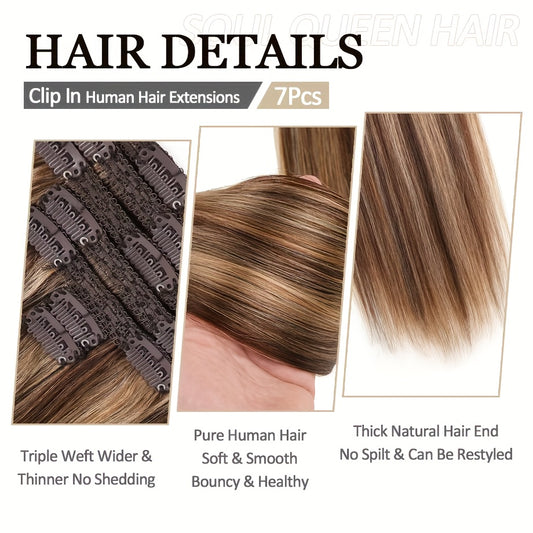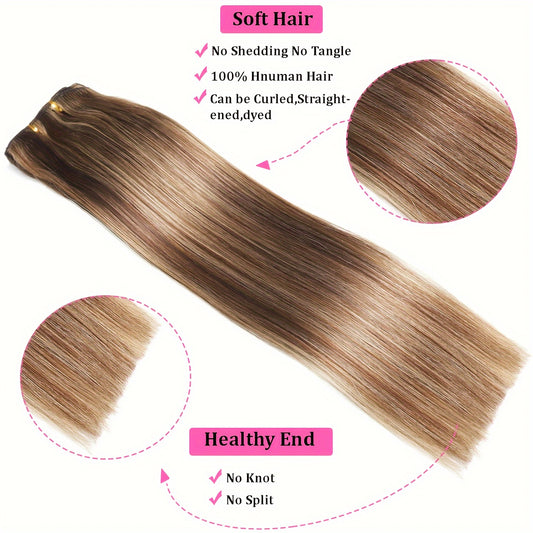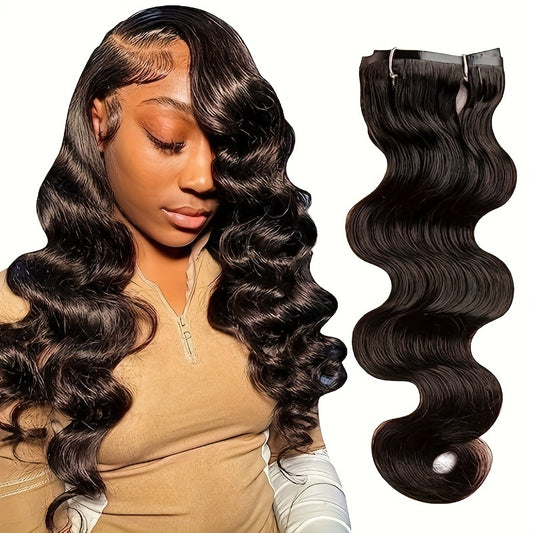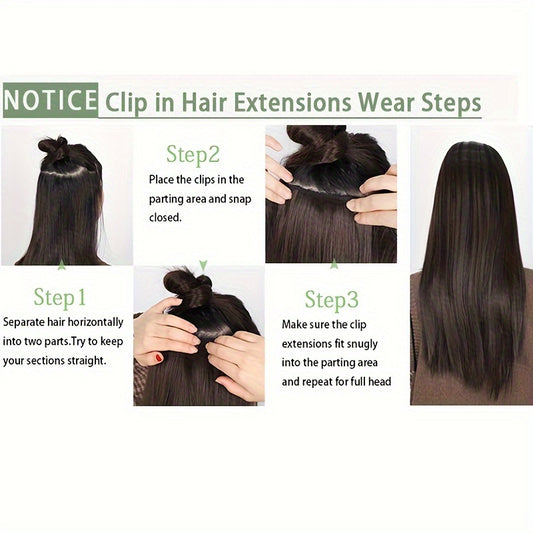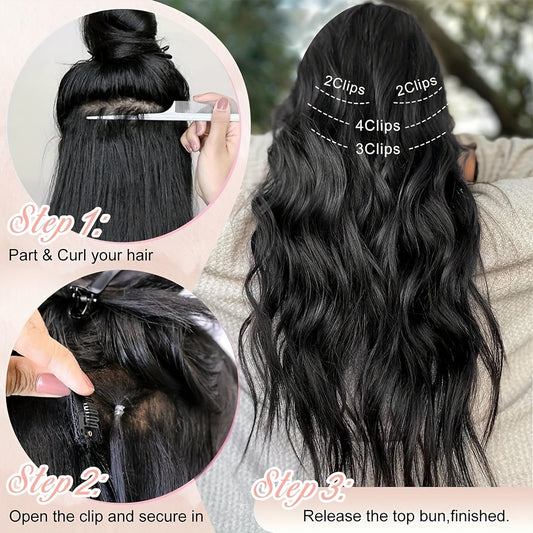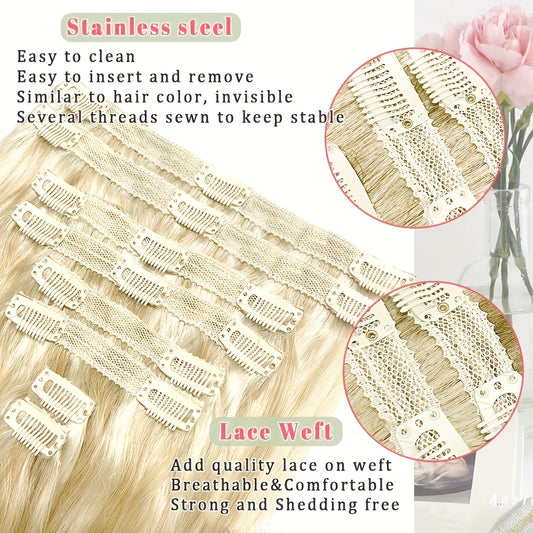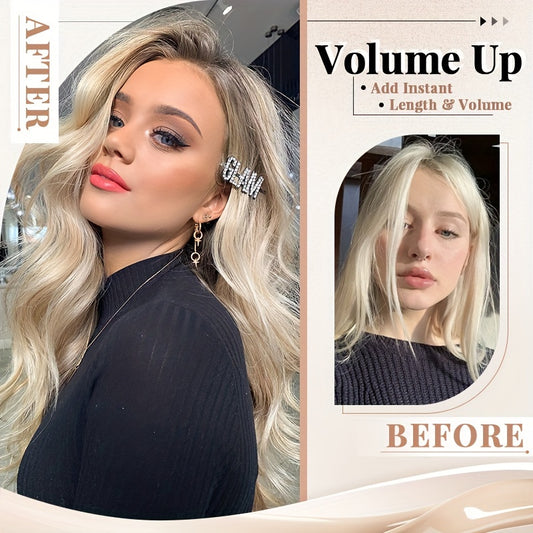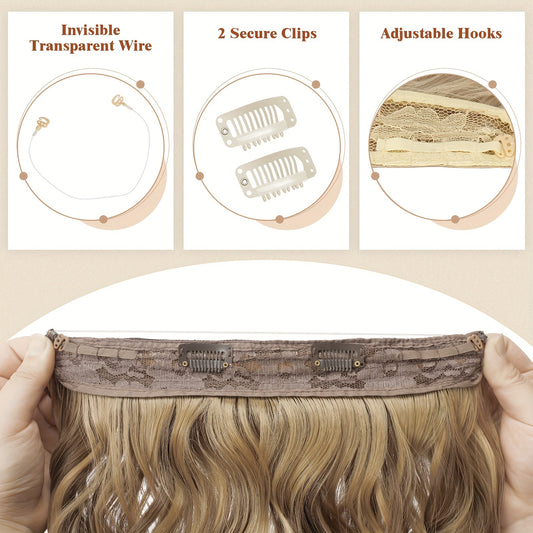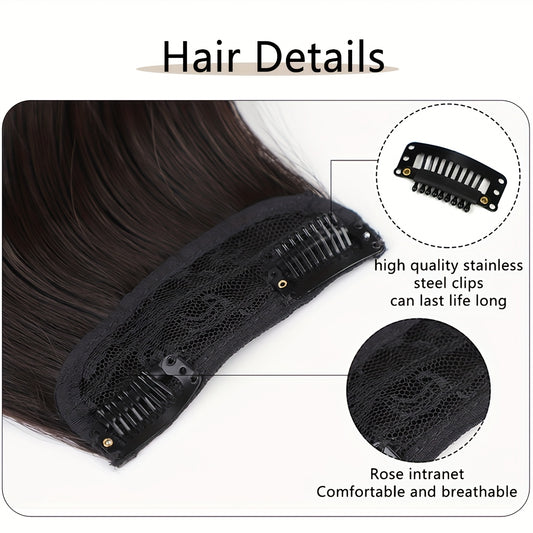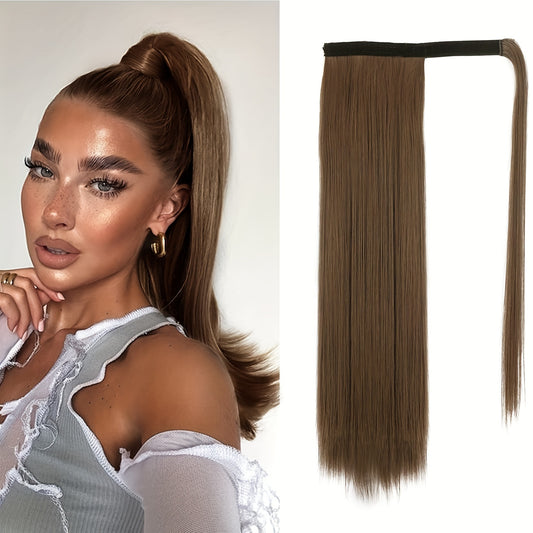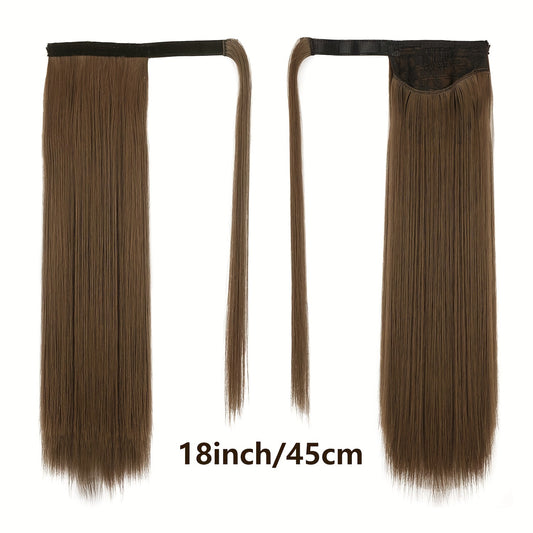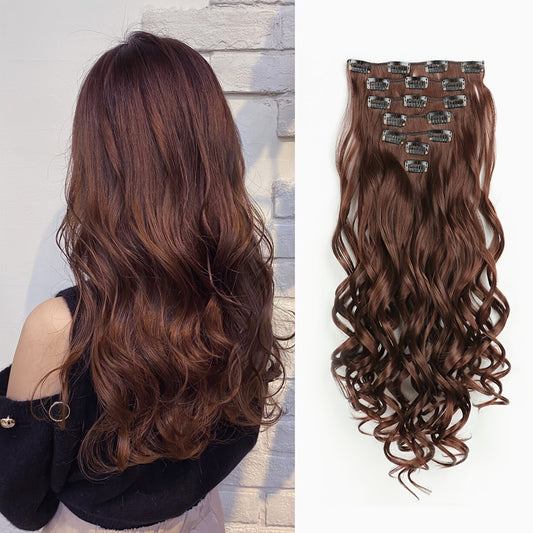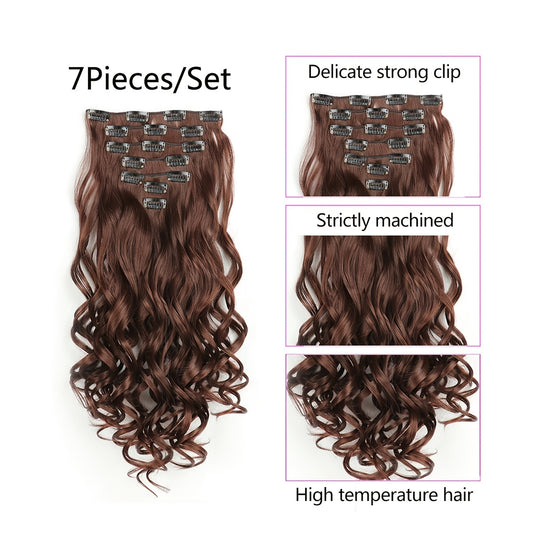About 18 Inch Clip In Hair Extensions
What the length looks like
On an average height frame, an 18 inch set finishes around mid chest in a straight style, a touch higher with soft waves, and noticeably higher with tight curls. Petite wearers will see the ends sit a bit higher; taller wearers with shorter necks often see the ends slightly lower. Jackets, scarves, and bag straps touch the hair more often than they do at 14 or 16 inches, so gentle brushing after removing layers keeps the outline crisp. A micro drop of serum on mid lengths and ends reduces static; keep roots product free so clips grip cleanly.
The camera pays attention to the bottom third of the silhouette at this length. If the hem looks thin, the style reads unfinished even if the top looks perfect. That is why grams and end profile matter more at 18 inches than they do at shorter sizes.
Who gains most from 18 inches
Wearers with shoulder length natural hair who want visible length plus stronger edges benefit most. Fine and medium strands gain stability because the added fiber holds round brush bends and curling iron sets. Presenters on camera, educators, and creators appreciate that 18 inches reads long without the maintenance of 22 inches. Event guests and brides like the reach for half ups, brushed wave sheets, and low buns. Travelers can still manage this length with a compact kit: loop brush, teasing comb, heat protectant, flexible spray, satin pouch, and two spare clips.
If natural hair is very short, coverage may be limited; consider a halo for a season, then move to clips when top layers lengthen. If natural hair is very dense and blunt, the set must carry enough grams to meet that line cleanly in straight finishes. The plan is not maximal volume; it is believable proportion.
Grams planning
Grams describe total hair weight in the set and directly control end fullness. A simple ladder prevents guessing. Subtle volume and better ends on layered cuts: ninety to one hundred twenty grams. Everyday full head that photographs dense yet feels light: one hundred thirty to one hundred sixty grams. Plush hem for blunt cuts, thicker strands, studio lighting, or humid climates: one hundred seventy to two hundred twenty grams. Very thick natural hair or precision straight looks under hard light may ask for even more, but that is the exception.
Buyers with one length bobs often underestimate grams. Without enough mass, the join between natural hair and extensions forms a shelf. Cameras amplify that line. Layered cuts hide the join naturally and tolerate fewer grams. A small note on the collection page mapping haircuts to grams reduces returns and improves first install success.
End profile and draw
Single drawn hair has a gentle taper toward the tips and reads like natural hair that has grown in over time. It brushes into movement easily and feels airy. Double drawn hair keeps more density in the bottom third and reads like a fresh salon cut—clean, deliberate, and strong in straight or beveled finishes. Neither choice is superior; it depends on your finish preference. If you wear sleek lines often, double drawn makes sense. If you prefer motion, single drawn is forgiving and romantic.
When only one draw is in stock you can shape the outline with a tiny trim of half an inch to one inch. That micro trim multiplies the impression of thickness without sacrificing the idea of 18 inches. The trick is to square the very bottom so the camera sees a single, confident edge.
Texture options explained
Straight texture creates glass hair and crisp geometry. Body wave is the universal blender for mixed routines, brushing straighter with a single pass or expanding into plush curves. Curly and coily textures work best when the coil diameter matches the wearer’s own pattern so stacking looks continuous. At this length, body wave is popular because it lifts the hem visually, reduces heat needs, and plays well with touch ups on busy days.
Choose base texture by daily habit. If you blow out most days, start straight. If you alternate between soft bends and loose curls, choose body wave clip ins. If you live in defined coils, select a coil diameter close to your own so the join vanishes when styled.
Color match logic
Match by undertone first—cool, neutral, or warm—and by depth second. Use daylight near a window; bathroom bulbs shift color and create false matches. If you sit between two shades, pick the slightly lighter option because Remy human hair extensions accept toners that cool or darken. Lifting lighter risks cuticle damage and shortens life. For darker roots, a rooted or balayage clip in option softens seams along parts and temples. A quick daylight photo of the match becomes a reliable reference for reorders and for small toner adjustments later.
Edge cases have simple fixes. Neutral cool brunettes reading warm indoors should trust the daylight view or apply a short cool glaze. Warm brondes that swing by environment like a rooted gradient. Deep browns with red cast should start neutral and tone cooler in small steps. Silver or gray blenders should begin neutral and use violet or blue toners lightly to tune undertone.
Why remy human hair matters
Remy hair keeps cuticles aligned in one direction. This lowers friction, reduces matting, and produces a soft, natural sheen instead of plastic glare. Remy responds predictably to moderate heat, which means one slow pass to straighten and low heat curls that hold after cooling. Gentle washing preserves the cuticle plates so the ends stay supple over months of use. If you need to adjust tone, demi level products can cool or deepen without harsh lifting.
At 18 inches the hem is always in the frame. Cuticle integrity is not a marketing detail; it is the reason the edge remains credible through photos, events, and travel.
Clip in method overview
Clip in hair extensions offer fast transformation with zero salon move ups. The mapping is consistent and easy to memorize. Anchor the widest weft above the nape. Place medium wefts as you climb the back of the head around the occipital area. Place narrow wefts at the sides to fill the temples and complete the face frame. Keep a generous top layer to cover hardware in wind or head turns. Light teasing and a single mist of flexible spray create reliable anchor points without bulk.
Sensitive scalps can run a lighter daily configuration and add two side pieces for events. Comfort comes from placement accuracy and from resisting the urge to over stack rows near the crown where the top layer is thin.
Placement blueprint
Detangle natural hair and wefts. Section horizontally above the nape and clip hair up. Tease lightly where clips will sit. Attach the center clip of the widest weft first, then the sides. Move one row upward by roughly a finger to an inch. Place the next widest weft. Add mediums as the skull curves, then narrow pieces at the sides. Keep the crown layer ample. For waves, alternate directions in the back and curl away from the face in front; allow full cooling before brushing. For straight styles, use heat protectant and cap tools at one hundred eighty Celsius or three hundred fifty Fahrenheit; one slow pass per section produces better polish than several quick zips.
If a seam shows, shift the part a few millimeters or add a narrow cover weft one step higher. If a temple looks shallow, trim one narrow piece on a slight diagonal and dedicate it to temple fill. These small moves tighten realism.
Blending and finishing
Cooling sets the shape; brushing while warm erases it. After curling, let hair cool fully before using a brush. To keep shine and reduce frizz, mist flexible spray onto the brush, not directly onto the hair, then sweep once. Finish with a pea of serum on mid lengths and ends only. For a straight look, pull sections taut and make a single deliberate pass, then let them cool untouched. A bevel of the very ends creates a groomed edge that reads like a fresh cut.
If the bottom line looks light in a straight photo, choose double drawn next time or request a micro trim. If the top looks slightly flat, over direct during blowout and let sections cool backward into place; this adds lift without teasing. Every adjustment is small and repeatable.
Everyday style set
Clean center part with a round brush bevel for professional polish. Deep side part for instant crown lift and asymmetry. Barrel waves brushed into a single S pattern that looks expensive on camera. Minimalist pinned sides to control flyaways without hiding length. Two micro braids at the temples for on trend texture with easy removal. Compact claw clip twist that stays neat under jackets and headphones. Sleek low pony with a wrapped strand for meetings or travel. Each style reads intentional without high product load.
Choose one daily pattern and one event pattern. Repeating the same moves makes results faster and more consistent. Consistency is a style amplifier: it makes hair read premium with less effort.
Care routine
Before wear, brush both natural hair and wefts using a loop brush or wide tooth comb. Support the weft with your free hand to avoid torque on stitching. After wear, brush again and coil the wefts in a gentle U before storing in a satin pouch. Wash clip ins every ten to fifteen wears or when product build up appears. Shampoo your natural hair and let suds pass through the extensions. Condition from mid lengths to ends, rinse cool, blot with microfiber, and air dry on a hanger.
During styling use heat protectant every time and keep tools under the limit. One slow pass gives more polish than three fast passes. Avoid heavy oils at the roots; they reduce clip grip. Rotate placement slightly day to day so the same follicles do not carry all the load.
Troubleshooting quick list
Weft flash in wind or bright light means the top layer is too thin or a part sits right over a seam; move the part slightly or add a higher cover weft. Wispy ends in photos call for a half inch trim or a double drawn set next order. Nape tangles under scarves or straps need end hydration and a temporary heat holiday. Clip slip on fine hair is solved by cleaning clip teeth and adding a light root texture mist; do not place clips on freshly conditioned areas. Color looks right outdoors but off indoors; trust daylight and, if needed, apply a short cool toner.
Scalp tenderness means reduce piece count, vary placement, and rest roots. Comfort is technique, not force. Small changes create durable improvements.
Workout and travel
Remove clip ins before high intensity exercise. It protects roots and saves detangling time later. For light sessions use a low braid and a soft headband, then brush only when hair is cool and dry. On flights, cabin air is dry; smooth a tiny drop of serum onto ends, store in satin, and refresh with a leave in mist after landing. For destination events, set curls, let them cool fully, brush to merge, and fix hold by misting the brush with flexible spray rather than spraying hair directly.
Pack a micro kit: loop brush, travel protectant, flexible spray, serum, spare clips, and a satin pouch. This solves almost every on the go scenario without heavy products or long routines.
Quality markers
Verified inputs matter more than adjectives. Look for 100 percent Remy human hair with aligned cuticles. Expect secure weft stitching with even density per centimeter and clean edges. Squeeze each clip to confirm strong recoil and smooth hinge action; silicone sleeves on the teeth should be uniform. Request daylight photos per shade on at least two complexions and a close crop of the ends at rest. Confirm that grams are measured post weft, not pre weft, for honest numbers.
Brands that publish a grams guide, a three step install primer, and a simple care card reduce misuse and returns. Honesty is the shortest path to long ownership and high satisfaction.
Page elements that help buyers
A good collection page starts with the exact length and method in the headline so searchers feel seen. The first image should show the same shade in daylight from front, side, and back. A cropped end shot proves density. One short line states where 18 inches lands on the body and typical install time. Filters show grams, texture, and shade families like blonde, bronde, brown, black, red, and gray. Each tile lists grams and texture and a tiny cue like everyday density or glam hem.
A how to apply expansion shows a three step diagram labeled section, anchor, blend. An FAQ covers heat limits, wash cadence, return eligibility for unopened hair, and an undertone tip. Color match hair extensions tools like a daylight photo uploader or quick chat assist are helpful if kept simple. Every sentence is a control, not a story.
Measure at home
To estimate landing point, stand straight and hold a soft tape behind the ear. Measure down to where you want the ends to reach on the chest. That number equals a straight finish target. Subtract about one inch for soft waves and more for defined curls. Try the measure while wearing a favorite blazer or neckline to judge proportion. If you like how the length frames that garment, you will likely like it in photos too.
Take a daylight photo of your current hair and a daylight photo of your chosen shade next to your mid lengths. Save both with the shade name and grams. This simple file becomes a reorder shortcut.
Comfort and safety
Clips should secure without pinching. If you feel a pull, reset the section, tease lightly, or shift the weft. Never sleep in clip in hair extensions. Keep oils away from roots and place serums only on mid lengths and ends. Rotate clip positions slightly each wear. If your scalp is sensitive, wear fewer pieces during regular days and add two for events. If you have a skin or scalp condition, consult a professional before use and test carefully.
Heat is a tool, not a crutch. Keep temperatures moderate and let sections cool untouched. One excellent pass is safer and shinier than several hot passes. Respect that rule and longevity increases automatically.
Use cases by routine
Office days benefit from a neat blowout or a sleek low pony; both sit cleanly under blazers and headsets. Teaching or streaming favors brushed wave sheets because they read polished on camera and resist flyaways. Weddings and formal events suit uniform curls brushed into a continuous pattern; the hair looks intentional from first look to last dance. Travel days favor a compact claw clip twist and a tidy ear tuck for motion without exposure. Gym sessions are clip out moments followed by a quick reinstall later.
Pick patterns that require little product and few passes. Low effort routines create high confidence because results repeat on demand.
Micro tactics that add up
Aim blow dryer airflow downward to align cuticles. Spray flexible hold onto the brush before the final sweep. Keep two ultra narrow side pieces dedicated to temple balance and label them in the pouch. Over direct crown sections forward during blowout, let them cool, then lay them back for lift without teasing. Use a gray card or phone white balance lock for accurate color photos.
When testing any new finishing product, try it first on a single small weft. If it behaves well, expand. Small tests prevent big mistakes.
Photography and accessibility
Use daylight around 5600K when capturing shade. Provide angles from front, side, and back with a crop of the ends at rest. Photograph each color on two different complexions and include a strand on white swatch to neutralize background bias. Avoid saturation boosts that distort undertone. For accessibility, pair shade names with numeric descriptors like level 6 neutral brown so color blind customers can map values. Ensure filter controls work by keyboard and announce changes to screen readers.
Alt text should include length, texture, and undertone rather than poetic color names alone. On mobile avoid thin gray text on image backgrounds; legibility drives trust.
Seasonal care notes
Cold, dry months increase static; add leave in hydration, lower heat, and brush after removing scarves. Hot, humid months expand texture; lean into body wave behavior, reduce oils, and set with flexible sprays rather than heavy creams. Windy climates ask for secure placement plus one slim cover weft higher than usual and an ear tuck plan. When traveling between climates, adjust product load on arrival and keep the routine light.
Seasonal tweaks are small; the core method stays the same. That stability keeps results calm through changes.
Hair science in short
Hair cuticles are tiny scales that overlap. When aligned in one direction, fibers slide with less friction and fewer knots. Heat softens bonds inside the hair so they can be reshaped; cooling resets the new shape. Excess heat breaks cuticles and invites roughness; heavy silicone films hide damage briefly and then wash off unevenly. Remy human hair extensions preserve cuticle direction and therefore respond predictably to low and moderate heat. That is why the rules emphasize one slow pass and full cooling.
Science explains the habits. Follow the habits and the hair behaves the same way, week after week.
Simple economics
Clip in systems often have the best cost per wear when you switch between styled hair and hair up days. Because the hair rests between uses, the fiber ages slower than semi permanent methods. A well kept Remy set can serve for months; when you divide cost by outings, it compares favorably to many single appointment services. Time is also money: five to eight minute installs replace travel and waiting for a chair. Clear instructions reduce returns, which keeps prices stable for everyone.
Repair beats replace. Spare clips and gentle care extend life more than any product swap. Clarity, not hype, is the strongest value booster.
Myths clarified
Myth: more grams always look better. Reality: grams must match head size and haircut; too much hair near the crown risks exposure and discomfort. Myth: high heat is needed for curl memory. Reality: moderate heat plus full cooling gives better hold and protects ends. Myth: rooted colors are only a style trend. Reality: a soft root is a blending tool that hides part seams. Myth: clips cannot be worn under hats. Reality: at 18 inches, lower placements and a light ear tuck keep coverage intact under most brims.
Myth: you must change everything at once to get results. Reality: one small change—like a micro trim or a part shift—often delivers the biggest improvement.
Vendor checklist
Ask for proof of cuticle alignment and post weft grams. Request daylight photos per shade on two skin tones. Inspect stitch regularity and edge finishing. Test clip recoil and confirm silicone sleeves. Confirm unopened returns policy and spare clip availability. Check that instructions and a care card are included. Consistency in these items predicts a stable user experience.
If any answer is vague, expect more friction later. Clear yes or no answers save your time.
Returns and policy basics
Hygiene seals and tamper labels protect both buyer and seller. Returns should apply only to unworn, unstyled hair kept in the original net and pouch. Processing time and return shipping rules should be clear before checkout. Color toned or altered items cannot be returned, which is why the daylight color check appears before any product is opened or treated. Simple policies reduce confusion and make support faster when needed.
Transparency is customer service. It builds patience when a real issue appears because expectations were set early.
Localization pointers
Use both inches and centimeters for length. Keep grams consistent across regions. Translate shade names in a way that preserves undertone meaning. Provide realistic shipping windows and customs notes. Show diverse complexions and hair types so international buyers see themselves in the catalog. Offer at least one support channel that replies across time zones with a clear response time target.
Localization is not decoration; it is access. It moves buyers from curiosity to purchase without confusion.
Constraints to respect
Very short natural hair above the jawline may not cover hardware; consider waiting or using a halo. Extremely dense natural hair may need higher grams or a professional method to look sharp in straight finishes. Daily high ponytails and top knots expose standard clip maps; down styles, half ups, and low buns are the optimized use cases. Medical or skin sensitivities require testing or professional advice. None of these are deal breakers, but they define best practice.
Know the limits and results remain smooth.
Glossary
Grams: total weight of the set. Draw: end fullness distribution—single tapers, double stays thick. Occipital: the back curve of the head where medium wefts sit. Rooted: slightly deeper tone at the top to blend parts. Balayage: gradual lightness through lengths to soften seams. Cover weft: narrow piece placed higher to hide joins. Perimeter: the visible outline of the hair in profile and back views.
These terms are enough for clear decisions; everything else is optional detail.
Summary
Eighteen inch clip in hair extensions give obvious length with practical upkeep. Choose grams that match your haircut so the edge looks intentional. Pick a base texture that supports your routine. Match color by undertone in daylight and consider rooted or balayage for darker roots. Place wefts with a simple map and blend by cooling fully and brushing once. Care with light hands and consistent heat discipline. The result is hair that looks like yours, only longer and more finished, with less effort than you might expect.
Keep the method small and repeatable and the hair will behave the same way every week. That predictability is the real win.
Customer reviews
- I picked 150 g after the gram guide and my 18 inch straight styles finally look complete without feeling heavy; waves last all day when I let them cool before brushing. — Ava Thompson, Manchester, United Kingdom ⭐⭐⭐⭐⭐
- The daylight color check helped me choose a neutral rooted shade; the seam disappears on camera and install is under six minutes now that I follow the section–anchor–blend steps. — Camila Vargas, Bogotá, Colombia ⭐⭐⭐⭐⭐
- My scalp is sensitive and these still feel fine; a little teasing plus light root spray kept the clips steady from the metro to a late client dinner. — Noor Al Farsi, Muscat, Oman ⭐⭐⭐⭐
- I went with body wave because I switch between blowouts and loose curls; the ends sit at mid chest and the edge looks clean in photos. — Élodie Bernard, Lyon, France ⭐⭐⭐⭐⭐
- Two slim side pieces solved my temple hollows and the half inch trim tip made the edge look like a fresh cut at this length. — Naledi Khumalo, Durban, South Africa ⭐⭐⭐⭐⭐
- I teach online and the 18 inch outline reads polished on screen—no plastic shine, just a smooth hem that stays neat through long sessions. — Jordan Ellis, Portland, USA ⭐⭐⭐⭐⭐
- Shipping was a day late so one star off, but the Remy quality shows in the cuticles and the clips have real spring; install and removal are easy. — Petra Kovářová, Brno, Czechia ⭐⭐⭐⭐
- I wore them from a ceremony to a reception; low bun first, brushed wave sheet later, and everything stayed secure without tugging. — Lior Shalev, Tel Aviv, Israel ⭐⭐⭐⭐⭐
- First time with extensions and the three step map made it simple; nape anchor, back structure, side balance, then cool and brush—looked natural immediately. — Sofia Duarte, Porto, Portugal ⭐⭐⭐⭐⭐
- I remove them for spin class and put them back for dinner; far fewer tangles than my old longer set and the hem stays sharp after a quick brush out. — Chloe Nguyen, Brisbane, Australia ⭐⭐⭐⭐⭐
Extra tips
Check each clip’s spring before wear; a weak clip should be swapped so the row stays stable. Label side wefts in the pouch so temple balancing is fast. When a brush snag starts, stop and support the weft with one hand while brushing from ends upward. If a part line looks stark on camera, dust a small amount of washable root powder for a soft shadow that hides seams. If a collar rubs the ends, tuck hair inside the collar while you put the coat on, then let it fall once settled.
Write down shade code, grams, texture, and tool temperatures in a notes app. That tiny record turns a good day into a system you can repeat without thinking. Systems keep hair easy.
Extra tips
Check each clip’s spring before wear; a weak clip should be swapped so the row stays stable. Label side wefts in the pouch so temple balancing is fast. When a brush snag starts, stop and support the weft with one hand while brushing from ends upward. If a part line looks stark on camera, dust a small amount of washable root powder for a soft shadow that hides seams. If a collar rubs the ends, tuck hair inside the collar while you put the coat on, then let it fall once settled.
Write down shade code, grams, texture, and tool temperatures in a notes app. That tiny record turns a good day into a system you can repeat without thinking. Systems keep hair easy.
Extra tips
Check each clip’s spring before wear; a weak clip should be swapped so the row stays stable. Label side wefts in the pouch so temple balancing is fast. When a brush snag starts, stop and support the weft with one hand while brushing from ends upward. If a part line looks stark on camera, dust a small amount of washable root powder for a soft shadow that hides seams. If a collar rubs the ends, tuck hair inside the collar while you put the coat on, then let it fall once settled.


